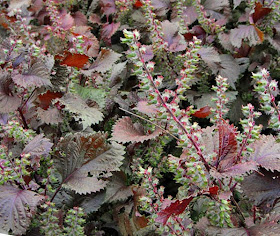Another up-and-coming chef herb this year is perilla or shiso. The two more common varieties of perilla
(Perilla frutescens) grow wild across the Ozarks region of Southern Missouri, including my garden. Both of these, the red and the green leaf varieties escaped from cultivation decades ago. Both can be found growing wild along roadsides and edges of fields in many places. Visitors to my garden have told me they thought it was wild basil, although it isn't remotely related to that plant. Both the red and green are simply
Perilla frutescens, also known as shiso, but both of these plants are quite strong flavored and not as desirable in cooking as the Vietnamese perilla
(Perilla frutescens var crispa). Of course that's my opinion, both the red and green varieties are used in Korean, Japanese, Chinese and other Asian cuisines, both as an ingredient and as a coloring agent.
 |
| Stronger flavored, this perilla grows wild in many parts of the U.S. |
But it is the cumin-scented perilla (not the one above) that I think has the better flavor and culinary uses. I found mine in a plant market near Tampa, Florida this past month. I've had starts before from a friend in Illinois but lost them to frost and hadn't collected any seeds.
 |
| Cumin scented perilla |
The plant varies from green, to green on top and red underneath the leaves, as in the one above. As Tom DeBaggio and Dr. Art Tucker said in
The Encyclopedia of Herbs: A Comprehensive Reference, "the application of the cultivar names is poorly defined in the literature. Many different scents of the beefsteak plant also exist." In other words, there are variations of scents in shiso (sometimes called beefsteak plant, mostly for the red-leaf varieties, so choosing the best fragrance and flavor is a mater of choice).
 |
| It's an attractive addition to the herb garden. |
Both the red and green varieties often called beefsteak plant due to the red of the leaves, is used in pickling in Japanese dishes. The green-leaf variety known as "Tia To" is milder and has the pleasant cumin scent and flavor. Other cultivars available include ‘Atropurpurea’ with dark purple leaves; ‘Crispa’ with crinkled bright purple or bronze leaves mottled with green or pink and ‘Laciniata’ with all-green, deeply incised leaves. Varieties 'Green Cumin' and 'Purple Cumin,' both readily available, have cumin-and cinnamon-scented leaves. 'Aojiso' has green ginger-scented leaves, often used with sashimi. 'Red' or 'Akajiso' has rich, deep red to purple leaves. The large-leafed 'Kkaennip' or Korean perilla is used in a variety of ways.
The leaves are used as a wrap in sushi, shredded on salads, mixed in Mesclun salad mixes, sprinkled over cucumbers, cabbage or fish dishes. Try the fresh leaves thinly shredded on a fish taco!
Try this perilla pesto served over pasta, fish or mixed with sour cream as a dip for vegetables.
Perilla Pesto
1/2 cup toasted almonds
3 garlic cloves
1/3 cup olive oil
2 cups fresh cumin-scented perilla leaves, torn in pieces
Juice of 1 fresh lime
1/2 teaspoon salt
In a food processor, coarsely chop the almonds, the add the remaining ingredients and pulse-chop until you have a spreadable pesto. This can be stored in the refrigerator, covered, for about 24 hours.
Seed for cumin-scented perilla aren't easily to find. I found only 2 companies that carry it:
Kitazawa Seed Co.
and
One-Garden, Inc.
When growing any perilla, be aware it will reseed itself. The cumin-scented one isn't prone to that and I've never had a volunteer plant come up in the garden. But the common red and green curly leaf ones that grow wild, can become a weed if you don't clip out the flowering tops before fall. Even then it's not an unpleasant plant to find in the garden and is easily controlled by mulching over it.





No comments:
Post a Comment
Because of the few comments I receive, except for the spam, I have removed the option of anyone being able to comment. If you have a comment and aren't signed up to follow this blog, you can sign up to follow, or send your comments to me by way of my website (link found elsewhere on the blog page). Thank you.
Note: Only a member of this blog may post a comment.